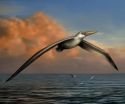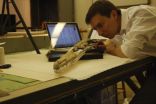(Press-News.org) Alexandria, Va. — Tucked high in the Andes Mountains of northern Peru is a remarkable fossil locality: a 39-million-year-old petrified forest preserved in nearly pristine condition: stumps, full trees, leaves and all. With its existence unknown to scientists until the early 1990s — and its significance unbeknownst to villagers — this ancient forest hosts the remains of more than 40 types of trees, some still rooted, that flourished in a lowland tropical forest until they were suddenly buried by a volcanic eruption during the Eocene.
Since its discovery a little more than two decades ago, scientists and other concerned citizens from Peru to Colorado have been working to study and preserve the spectacular site — now known as El Bosque Petrificado Piedra Chamana — and its unusual and diverse fossils. Read more about what scientists have learned so far and about the efforts to preserve the site in the July issue of EARTH Magazine: http://bit.ly/TpPLWu.
For more stories about the science of our planet, check out EARTH Magazine online or subscribe at http://www.earthmagazine.org. The July issue, now available on the digital newsstand, features stories on the crazy coloration of dinosaur feathers and how fieldwork has revised the ice-free corridor hypothesis of human migration, as well as a commentary examining the deadly landslide in Washington and emphasizing the need for better planning and insurance, plus much, much more.
INFORMATION:
Keep up to date with the latest happenings in Earth, energy and environment news with EARTH magazine online at: http://www.earthmagazine.org. Published by the American Geosciences Institute, EARTH is your source for the science behind the headlines.
The American Geosciences Institute is a nonprofit federation of 49 geoscientific and professional associations that represents more than 250,000 geologists, geophysicists and other earth scientists. Founded in 1948, AGI provides information services to geoscientists, serves as a voice of shared interests in the profession, plays a major role in strengthening geoscience education, and strives to increase public awareness of the vital role the geosciences play in society's use of resources, resiliency to natural hazards, and interaction with the environment.
EARTH Magazine: Preserving Peru's petrified forest
2014-07-07
ELSE PRESS RELEASES FROM THIS DATE:
New study of largely unstudied mesophotic coral reef geology
2014-07-07
MIAMI – A new study on biological erosion of mesophotic tropical coral reefs, which are low energy reef environments between 30-150 meters deep, provides new insights into processes that affect the overall structure of these important ecosystems. The purpose of the study was to better understand how bioerosion rates and distribution of bioeroding organisms, such as fish, mollusks and sponges, differ between mesophotic reefs and their shallow-water counterparts and the implications of those variations on the sustainability of the reef structure.
Due to major advancements ...
Discovery of Neandertal trait in ancient skull raises new questions about human evolution
2014-07-07
Re-examination of a circa 100,000-year-old archaic early human skull found 35 years ago in Northern China has revealed the surprising presence of an inner-ear formation long thought to occur only in Neandertals.
"The discovery places into question a whole suite of scenarios of later Pleistocene human population dispersals and interconnections based on tracing isolated anatomical or genetic features in fragmentary fossils," said study co-author Erik Trinkaus, PhD, a physical anthropology professor at Washington University in St. Louis.
"It suggests, instead, that ...
Bruce Museum scientist identifies world's largest-ever flying bird
2014-07-07
GREENWICH, CT, EMBARGOED UNTIL JULY 7, 2014 (3:00 PM EST) -- Scientists have identified the fossilized remains of an extinct giant bird that is likely to have the largest wingspan of any bird ever to have lived. A paper announcing the findings, "Flight Performance of the Largest Volant Bird," was published July 7 in the journal Proceedings of the National Academy of Sciences, and is authored by Dr. Daniel Ksepka, the newest Curator of Science at the Bruce Museum in Greenwich.
With a wingspan of 20 to 24 feet, Pelagornis sandersi was more than twice as big as the Royal ...
Scientist identifies world's biggest-ever flying bird
2014-07-07
DURHAM, N.C. -- Scientists have identified the fossilized remains of an extinct giant bird that could be the biggest flying bird ever found. With an estimated 20-24-foot wingspan, the creature surpassed size estimates based on wing bones from the previous record holder -- a long-extinct bird named Argentavis magnificens -- and was twice as big as the Royal Albatross, the largest flying bird today. Scheduled to appear online the week of July 7, 2014, in the journal Proceedings of the National Academy of Sciences, the findings show that the creature was an extremely efficient ...
Mathematical model illustrates our online 'copycat' behavior
2014-07-07
Researchers from the University of Oxford, the University of Limerick, and the Harvard School of Public Health have developed a mathematical model to examine online social networks, in particular the trade-off between copying our friends and relying on 'best-seller' lists.
The researchers examined how users are influenced in the choice of apps that they install on their Facebook pages by creating a mathematical model to capture the dynamics at play. By incorporating data from the installation of Facebook apps into their mathematical model, they found that users selected ...
Time of day crucial to accurately test for diseases, new research finds
2014-07-07
A new study published today in the journal PNAS (Proceedings of the National Academy of Sciences), has found that time of day and sleep deprivation have a significant effect on our metabolism. The finding could be crucial when looking at the best time of day to test for diseases such as cancer and heart disease, and for administering medicines effectively.
Researchers from the University of Surrey and The Institute of Cancer Research, London, investigated the links between sleep deprivation, body clock disruption and metabolism, and discovered a clear variation in metabolism ...
The quantum dance of oxygen
2014-07-07
Perhaps not everyone knows that oxygen has – quite unusually for such a simple molecule – magnetic properties. The phase diagram of solid oxygen at low temperatures and high pressures shows, however, several irregularities (for example, proper "information gaps" with regard to these magnetic properties) that are still poorly understood. A team of researchers from the International School for Advanced Studies (SISSA) and International Centre for Theoretical Physics Abdus Salam (ICTP) of Trieste, while trying to understand the origin of these phenomena, have identified a ...
DNA of 'Evolution Canyon' fruit flies reveals drivers of evolutionary change
2014-07-07
Scientists have long puzzled over the genetic differences between fruit flies that live hardly a puddle jump apart in a natural environment known as "Evolution Canyon" in Mount Carmel, Israel.
Now, an international team of researchers led by scientists with the Virginia Bioinformatics Institute at Virginia Tech has peered into the DNA of these closely related flies to discover how these animals have been able to adapt and survive in such close, but extremely different, ecologies.
One reason lies in a startling abundance of repetitive DNA elements that, until recently, ...
High earners in a stock market game have brain patterns that can predict market bubbles
2014-07-07
If you're so smart, why aren't you rich? It may be that, when it comes to stock market success, your brain is heeding the wrong neural signals.
In a study in the Proceedings of the National Academy of Sciences this week, scientists at the Virginia Tech Carilion Research Institute and Caltech found that, when they simulated market conditions for groups of investors, economic bubbles — in which the price of something could differ greatly from its actual value — invariably formed.
Even more remarkably, the researchers discovered a correlation between specific brain activity ...
Negar Sani solved the mystery of the printed diode
2014-07-07
VIDEO:
The video shows how a printed label picks up the radio signal from a telephone making a call, and uses the energy to switch the integrated display. This is only...
Click here for more information.
With an article published in the Proceedings of the National Academy of Sciences in the United States of America (PNAS), a thirteen-year-long mystery that has involved a long series of researchers at both Linköping University and Acreo Swedish ICT has finally been solved.
The ...







